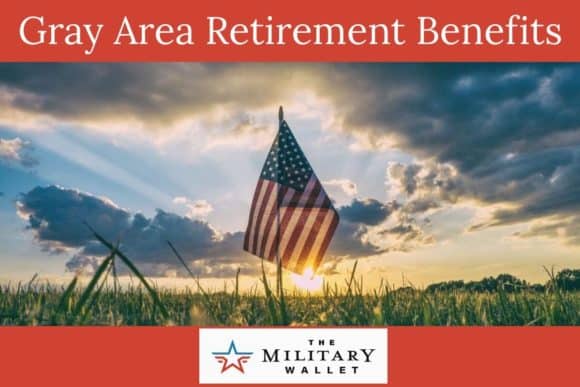Table of Contents
Although being in the “gray area” doesn’t generally seem desirable for retired Guardsmen or Reservists, there are various benefits associated with being “in-between” service and full retirement. If you or a family member has served at least 20 good years and is transitioning out of the National Guard or Reserve, this article is for you. Read on to learn about important benefits that you and your dependents may be eligible for.
What Is a Gray Area Retiree?
Despite the relatively unflattering title, a “gray area” retiree is a retired Guardsman or Reservist who has completed at least 20 years in service but is not quite old enough (usually 60 years of age) to collect their full retirement pay and benefits. Since they fall into a somewhat awkward benefits camp, they are referred to as being in the “gray area” and have access to a slightly restricted list of benefits compared with full retirees.
The “gray area” includes active Reserve Component (RC) members, Individual Ready Reserve (IRR) members, and Retired Reserve servicemembers who have served over 20 years but are not yet eligible for retirement pay.
As of Oct. 2020, “gray area” retiree applications are now managed by the Department of Defense’s Gray Area Retirements Branch. Those seeking to avail of their “full” retirement benefits must apply before reaching their approved retirement age to collect retirement pay.
Veterans residing in the “gray area” are not yet eligible to collect their pension and avail of Tricare healthcare, but they do have access to certain benefits, such as:
- Military exchange stores (PX, NEX, MCX, etc.)
- Commissaries
- Morale, Wellness, and Recreation facilities
- And more
Eligibility Requirements
To be considered a “gray area” retiree, the servicemember must have completed at least 20 years in the National Guard or Reserves (including any applicable active duty service time).
When out-processing, the servicemember must obtain a new military identification card reflecting the new “gray area” status and update their information in DEERS. Remember that yet another military identification card will be necessary once the servicemember reaches “full” retirement age.
Gray Area Benefits vs. Full Retirement Benefits
The following table can help you better understand which benefits are available tp you immediately upon retiring from the Guard or Reserves and which you will have to wait to receive (generally until age 60).
| Your Benefits | Gray Area Retiree – Retiree & Dependents (Under Age 60) | Full Retirement Age – Retiree & Dependents (Age 60 and Up) |
|---|---|---|
| Military Retirement Pay | No (unless eligible for early retirement benefits). DFAS Logon available when retirement pay starts. | Yes |
| Military ID Cards | Upon retirement: Must obtain a new Gray Area ID card for self and dependents. Must enroll in DEERS as a retiree. | Must obtain a new ID card for self and dependents at age 60 Verify DEERS enrollment still valid. |
| Military Installation Access | Yes (SOFA laws may impact access OCONUS) | Yes (SOFA laws may impact access OCONUS) |
| Exchanges / BX / NEX / PX / Shopettes / Gas Stations | Yes (SOFA laws may impact access OCONUS) Gas coupons not available to retirees OCONUS. | Yes (SOFA laws may impact access OCONUS) Gas coupons not available to retirees OCONUS. |
| Commissary | Yes (SOFA laws may impact access OCONUS) | Yes (SOFA laws may impact access OCONUS) |
| Military Medical Facilities | No | Yes – Space Available Only |
| Health Insurance: Tricare or US Family Health Plan | Eligible for Tricare Retired Reserve (TRR) until age 60. Must be enrolled in DEERS and pay premiums. | Age 60: Eligible for Tricare Prime, Tricare Standard, or US Family Health Plan Age 65: Eligible for Tricare for Life (requires Medicare Part B). Dependent children may be eligible for Tricare Young Adult. Must be enrolled in DEERS and pay required enrollment fees and/or premiums. |
| Dental Care & Vision Care | Available through the Federal Employees Dental and Vision Insurance Program (FEDVIP). Must pay premiums. | Available through the Federal Employees Dental and Vision Insurance Program (FEDVIP). Must pay premiums. |
| Base Lodging | Yes; Space available only. | Yes; Space available only. |
| Base Amenities and MWR Facilities: (Base gym, Officer & Enlisted Clubs, library, theater, rentals, etc.) | Yes | Yes |
| Space-A Travel | Retired member only; dependents are not eligible. Limited to CONUS locations. | Full Space-A benefits for Retiree and Dependents to CONUS and OCONUS locations. Retired member must accompany spouse and dependent children. |
| Base Family Services | Yes | Yes |
| Base Legal Office Assistance | None | Yes |
| Survivor Assistance / Casualty Assistance | Yes | Yes |
Overview of Benefits
Military Installation Facilities and Activities
“Gray area” retirees retain access to on-base post exchanges, commissaries and Shoppettes, service stations, fitness centers, and other on-base facilities such as theaters, Officer or NCO clubs, bowling alleys, libraries, flower and optical shops, barbershops, laundry facilities, MWR programs, and ITT offices.
Additionally, “gray area” retirees and their dependents have access to on-post lodging on a “first come-first served” basis.
Dental Care
Although Gray Area retirees limited access to Tricare health insurance until they hit their “full” retirement age, they can apply for the premium-based Federal Employees Dental and Vision Insurance Program. FEDVIP, as it’s known, is the U.S. government-sponsored dental insurance program that replaced the Tricare Retiree Dental Program in Dec. 2018.
Discounted and Space-A Travel
Lodging at Armed Forces Recreation Centers is available to all military ID holders, including “gray area” retirees, which is a tremendous benefit for those hoping to visit Disney World with their family, escape to the mountains of Bavaria, or relax on the beaches of Oahu.
Additionally, space available (“space-A”) travel is open to “gray area” retirees, but only within the continental United States. Also, spouses and dependents of “gray area” retirees do not qualify for this benefit, so servicemembers should prepare to fly solo until they hit their full retirement age.
Finally, “gray area” retirees can still take advantage of CWT/SATO travel services.
Family Services and Survivor Assistance
“Gray area” retirees are eligible for some on-base legal services but are entitled to all survivor assistance, casualty assistance, and family service benefits awarded to “full” retirees.
For a full and up-to-date (as of Sept. 2020) list of all “gray area” retiree benefits, see HRC’s Gray Area overview.
What Benefits Are Excluded Until Age 60?
Healthcare
A critical exclusion for “gray area” retirees is healthcare. Members of the Guard and Reserves who are not also federal employees are eligible for subsidized healthcare through Tricare Reserve Select. Access to Tricare Reserve Select ends when the member retires, at which point they can apply for Tricare Retired Reserve until they reach age 60, which is the full retirement age for healthcare benefits.
Note: Tricare Retired Reserve is virtually the same as Tricare Reserve Select. However, there is no premium subsidy from the government. Retirees will have to pay the full price, which can be expensive. Many retired Reserve members choose to obtain healthcare coverage through a civilian employer or a spouse’s employer, if available. Here is more information about healthcare options for retired Reservists.
Once retired Guard and Reserve members reach the full retirement age of 60, they will be eligible for Tricare Prime or Tricare Select. They will also be eligible to apply for Tricare Young Adult for eligible dependents. At age 65, they will become eligible for Tricare for Life.
Retirement Pay and Benefits
Finally, to receive “full” retirement pay, servicemembers typically have to wait until they turn 60 years old. However, early retirement benefits for Reserve Component members who meet specific eligibility criteria were authorized within the 2008 National Defense Authorization Act (NDAA) and further amended in 2015.
This legislation makes it easier for those Reservists or Guardsmen who were activated in support of overseas operations after Jan. 2008 to begin receiving retirement pay three months early for each 90-day period they served in any given fiscal year. Therefore, if a “gray area” retiree was activated to support a 9-month overseas deployment after Jan. 2008, they could receive early retirement benefits as much as 9 months before their original eligibility date.
Space-A Travel
Space-A travel for Gray Area retirees can only fly within the Continental United States (CONUS) and directly between the CONUS and Alaska, Hawaii, Puerto Rico, the US Virgin Islands, Guam, and American Samoa.
However, Space-A travel for spouses and dependents of retired servicemembers is only available once the servicemember reaches “full” retirement age.
So, Space-A travel is an option if you are traveling solo, but it may not be an option if you wish to bring family members. So it may be worth it to delay that big trip to Europe until the entire family is eligible for Space-A travel.




About the comments on this site:
These responses are not provided or commissioned by the bank advertiser. Responses have not been reviewed, approved or otherwise endorsed by the bank advertiser. It is not the bank advertiser’s responsibility to ensure all posts and/or questions are answered.